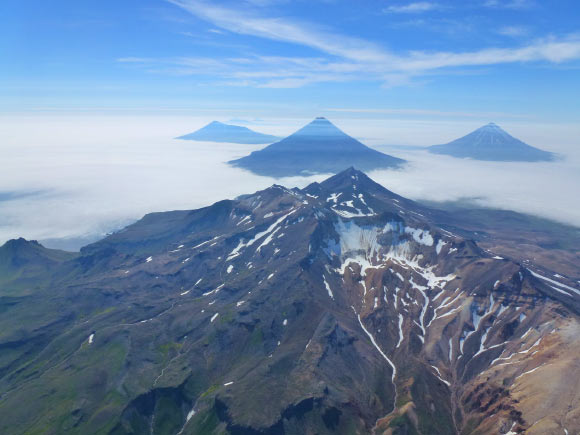The Islands of Four Mountains, a small group of volcanic islands in the central Aleutians, could actually be part of a single, undiscovered giant volcano in the same category as Yellowstone, according to new research.

An aerial oblique photo of the volcanoes in the Islands of Four Mountains, Alaska, taken in July 2014. In the center is the summit of Mount Tana. Behind Tana are (left to right) Herbert, Cleveland, and Carlisle volcanoes. Image credit: John Lyons / USGS.
The Islands of the Four Mountains are a volcanic archipelago in the central Aleutian arc comprised of six closely spaced stratovolcanoes (Carlisle, Cleveland, Herbert, Kagamil, Tana and Uliaga).
One of them, Mount Cleveland, is one of the most persistently active volcanoes in North America over the past 20 years with eruptive activity characterized by small explosions that produce ash clouds that rise 4.5 to 9 km (15,000-30,000 feet) above sea level.
Dr. Diana Roman, a researcher at the Carnegie Institution for Science, and her colleagues have been studying Mount Cleveland trying to understand the nature of the archipelago.
They have gathered multiple pieces of evidence showing that the islands could belong to one interconnected caldera.
Unlike stratovolcanoes, which tend to tap small- to modestly-sized reservoirs of magma, a caldera is created by tapping a huge reservoir in the Earth’s crust.
When the reservoir’s pressure exceeds the strength of the crust, gigantic amounts of lava and ash are released in a catastrophic episode of eruption.
Caldera-forming eruptions are the most explosive volcanic eruptions on Earth and they often have had global effects.
The ash and gas they put into the atmosphere can affect Earth’s climate and trigger social upheaval.
“If confirmed, it would become the first in the Aleutians that is hidden underwater,” Dr. Roman said.
“We’ve been scraping under the couch cushions for data. But everything we look at lines up with a caldera in this region.”
Despite all these signs, the scientists maintain that the existence of the caldera is not by any means proven.
To do that, they will need to return to the islands and gather more direct evidence to fully test their hypothesis.
“Our hope is to return to the Islands of Four Mountains and look more closely at the seafloor, study the volcanic rocks in greater detail, collect more seismic and gravity data, and sample many more of the geothermal areas,” Dr. Roman said.
“The caldera hypothesis might also help explain the frequent explosive activity seen at Mount Cleveland.”
The team will present the findings next week at the AGU’s Fall Meeting 2020.
_____
John A. Power et al. 2020. Multi-Disciplinary Evidence for a Large, Previously Unrecognized Caldera in the Islands of Four Mountains, Central Aleutian Arc, Alaska. AGU20 19: 28







